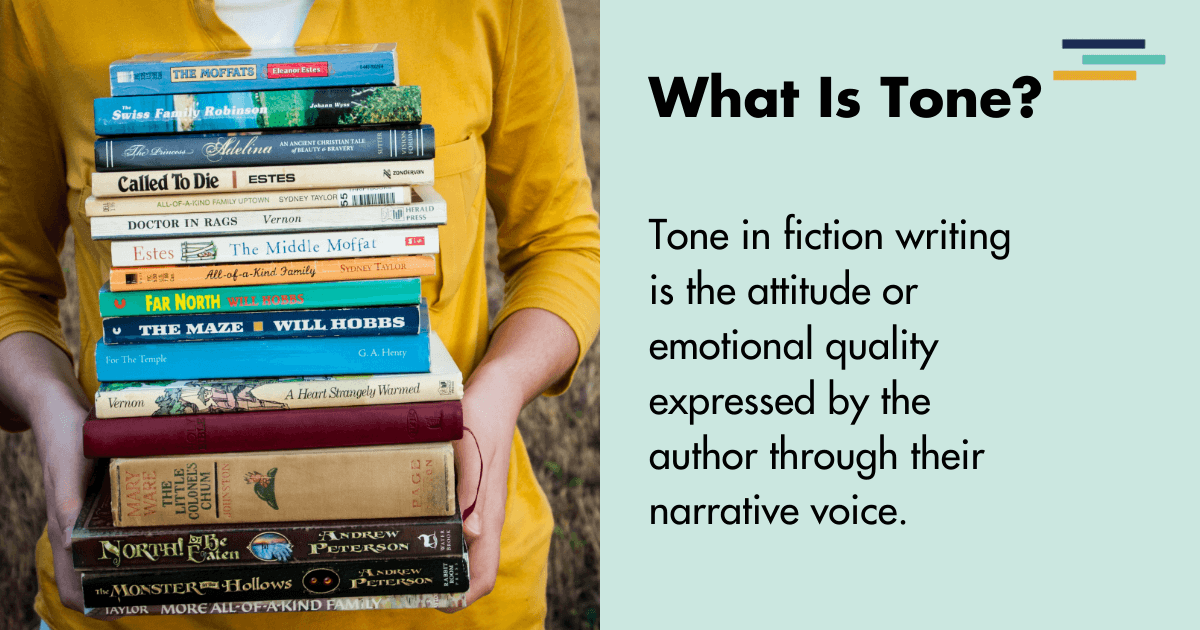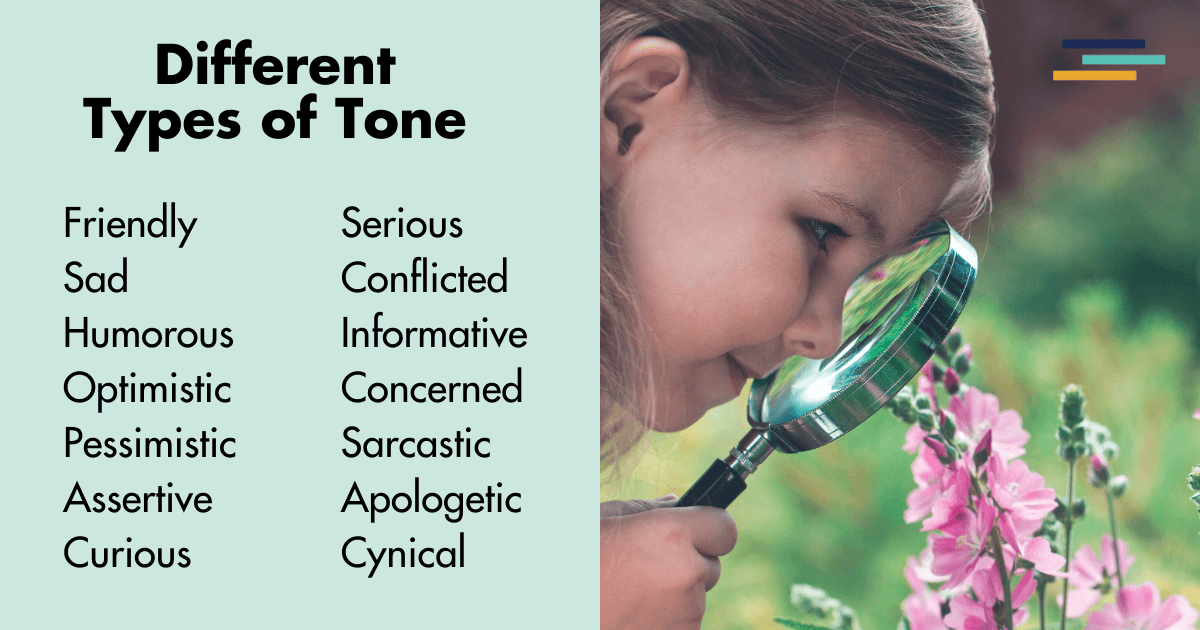
“In the beginning, there was tone.”
Tone is an elusive yet powerful force in writing that shapes our perception of stories. As writers, we wield tone in magical ways, conjuring emotions, building suspense, and guiding our readers through the mundane and the extraordinary.
What is Tone?
Tone in fiction writing refers to the attitude or emotional quality expressed by the author through their narrative voice. It is like the brushstroke of a painter—it colors the canvas of your narrative, setting the overall mood or atmosphere of the story and influences how readers perceive the events, characters, and themes. Tone can vary widely depending on genre and the author’s intent.
Another way to think of tone in literature is to compare it to tone of voice. How you say something can provide infinitely more meaning than just the words themselves.
If I tell my dog, “You’re a good girl,” but I say it in a stern tone, her ears droop and she cowers. Changing my tone to one of encouragement, she responds with a wagging tail and an affectionate slurp. The words are important (not as much to my dog, but you get the drift), but the tone shapes the emotional response I hope to achieve.
When you send a text, do you ensure it carries the intended tone? Replying to someone with “Whatever” could mean many things, like “Sure, Yes, I guess, I don’t care,” or even imply anger, sarcasm, or other emotions. Without tone, it’s not always possible to rely just on words alone to convey the intended meaning.

What’s the Difference Between Tone, Mood, and Voice?
Tone refers to the attitude or emotion the writer has conveyed in a scene, whether through dialogue, setting, or action. It sets the atmosphere and influences how readers perceive the text.
Tone reflects the author’s point of view and their attitude toward the audience. Unlike mood or voice, tone is situational. For example, a character’s voice and its peculiarities remain constant throughout a story, but the tone of their voice will change based on what they’re experiencing.
Mood pertains to the emotional feeling or vibe created by the writer’s choice of words, imagery, and setting. It’s much more about the reader’s response and the mood the writer evokes in them. The author writes (the cause) and the reader reacts (effect).
Voice refers to the author’s distinctive style and personality that comes through in their writing. It’s like their fingerprint on the page and encompasses their tone, choice of words, sentence structure, and perspective. Voice is what sets one writer’s work apart from another and makes it recognizable.
Tone can vary within a writer’s work, expressed by different characters or settings. Imagine the use of a character’s body language, facial expressions, and quirks to differentiate tone. The author may set a tense, suspenseful mood through the setting and plot of a thriller novel but may include scenes with a character who is oblivious to the circumstances, giving those scenes a comical tone.
Different Types of Tone
There’s really no limit to the number of ways to describe tone. Here are several, along with examples. Remember, it’s possible for a single literary work to encompass multiple tones.
Friendly Tone
A friendly tone conveys warmth, familiarity, and builds a sense of ease and rapport with the reader. Examples of books written with a friendly tone include:
- The Guernsey Literary and Potato Peel Pie Society by Mary Ann Shaffer and Annie Burrows: This charming novel is written in the form of letters exchanged between characters, creating an intimate and friendly atmosphere. Set in post-World War II England, it explores love, friendship, and the power of literature.
- Eleanor Oliphant Is Completely Fine by Gail Honeyman: A heartwarming story about the endearing misfit Eleanor, whose lonely existence is changed when she and a coworker help an elderly man who has taken a fall.
Sad Tone
A sad tone tugs at the reader’s heartstrings. It’s best used for poignant moments, tragic events, or reflective passages. Examples include:
- The Fault in our Stars by John Green: A heartfelt examination of life, love, and the impact of terminal illness that is heartbreakingly real.
- Only Love Can Hurt Like This by Paige Toon: A heartbreaking love story about Wren, whose fiance has left her, and Anders, whose wife died four years earlier. They cross paths and sparks fly, but Anders harbors a secret with serious consequences for all if he acts on his feelings for Wren.
Humorous/Playful/Witty/Goofy Tone
Puns, witty banter, and quirky characters thrive in this tone. Examples include:
- The Stephanie Plum series by Janet Evanovich: Stephanie Plum is a feisty character who becomes a bounty hunter. Described as a combination of Dirty Harry and Nancy Drew, Stephanie’s exploits display humor and relatability.
- The Hitchhiker’s Guide to the Galaxy by Douglas Adams: This book, celebrated for its wit and satirical humor, is the tale of an ordinary man who embarks on an extraordinary space adventure after Earth is destroyed to make way for a galactic freeway.
Optimistic/Lighthearted/Cheerful Tone
An optimistic tone may convey an upbeat outlook while acknowledging that things may not be perfect. It celebrates resilience, connection, and the brighter aspects of life. Reading these may brighten your day:
- A Man Called Ove by Fredrik Backman: This heartwarming tale explores the profound impact one life can have on countless others. When Ove, a curmudgeon with staunch principles and strict routines, meets boisterous new neighbors, unexpected friendship blooms.
- The Authenticity Project by Clare Pooley: A feel-good story about a group of strangers who come together when making entries in a shared diary and find their lives changed as a result.
Pessimistic Tone
A pessimistic tone is one of caution and negativity and is often used as a warning against potential danger. Books with this tone often explore themes of despair, disillusionment, and the darkest aspects of human experience. These books are excellent examples:
- 1984 by George Orwell: A classic dystopian novel that presents a grim vision of a future where individuality and independent thought are suppressed by a government that controls every aspect of people’s lives.
- Lord of the Flies by William Golding: This novel delves into the dark side of human psychology when a group of marooned schoolboys descend into savagery.
Assertive Tone
Uses the characters’ attitudes, dialogue, and the narrative’s approach to showcase assertive tones. Works with this tone include:
- Atlas Shrugged by Ayn Rand: This novel is famous for its assertive and philosophical dialogue, reflecting Rand’s Objectivism philosophy. The characters are fighting oppressive laws and regulations on businesses in a dystopian United States.
- The Fountainhead by Ayn Rand: Another of Rand’s works, this book features assertive and strong-willed characters, particularly the protagonist, Howard Roark, who stands firm in his architectural principles against conventional standards.
Curious Tone
A curious tone invites exploration and can make stories intriguing and engaging. Perfect for mysteries, quests, or unraveling secrets. Examples of stories using a curious tone are:
- Sherlock Holmes stories by Arthur Conan Doyle: Holmes, the brilliant detective, approaches cases with a curious and analytical mind. His relentless pursuit of truth and attention to detail make the mysteries captivating.
- Alice’s Adventures in Wonderland by Lewis Carroll: Carroll’s whimsical tale is a delightful exploration of Alice’s curious journey through a fantastical world. The nonsensical characters, riddles, and unexpected twists create an atmosphere of wonder and curiosity.

Serious Tone
Books with a serious tone often delve into complex themes and present their narratives with gravity and depth. Titles include:
- Under the Whispering Door by T.J. Klune: A poignant reflection on the significance of life and the acceptance of death.
- The Deserter by Shannon Myers: A serious and intense read for adults. It delivers a gripping narrative set in a gritty world of motorcycle clubs and forbidden love where the unnamed protagonist defies rules and is no hero.
Conflicted Tone
Books with a conflicted tone often explore the internal struggles of characters, presenting narratives where protagonists grapple with opposing desires, beliefs, or obligations. Here are some books that employ a conflicted tone:
- Crime and Punishment by Fyodor Dostoevsky: This classic novel delves into the moral dilemmas of Raskolnikov, a former student who commits a crime and is torn between self-justification and guilt.
- The Goldfinch by Donna Tartt: The story follows Theo Decker, who survives a terrorist attack on an art museum that takes his mother’s life. He is left navigating grief, guilt, and the complex world of art crime.
Informative/Pragmatic Tone
A pragmatic tone is typically used when information must be delivered quickly, so there’s a focus on practical solutions and results.
- Michael Connelly’s crime novels, including Harry Bosch series, Mickey Haller series, Renee Ballard series: Connelly, a former reporter, uses an informative tone with attention to detail and factual accuracy that creates a compelling reading experience.
Concerned Tone
A concerned tone reflects genuine worry, love, or apprehension that deepens character relationships and evokes empathy and emotional engagement. Examples are:
- The Lovely Bones by Alice Sebold: Narrated by a murdered girl observing her family from the afterlife, this novel combines a concerned tone with themes of loss, love, and closure.
- The Kite Runner by Khaled Hosseini: Set in Afghanistan, this book explores friendship, betrayal, and redemption. The concerned tone resonates as the characters grapple with guilt and forgiveness.
Sarcastic Tone
A sarcastic tone winks at readers. It adds wit, humor, and a unique perspective. Books known for sarcastic characters or overall tone include:
- The Perry Jackson and the Olympians series by Rick Riordan: All of these books, especially The Last Olympian, feature the protagonist, Percy, using humor and sarcasm with mythology to navigate the challenges of being a demigod.
- Black Buck by Mateo Askaripour: A satirical novel that follows a young black man recruited to work at a tech startup.
Apologetic/Regretful Tone
This tone is often used to express regret, guilt, or reflection on past actions within a narrative. Here are some novels where characters or narrative voice express these sentiments:
- Atonement by Ian McEwan: The title itself suggests an apologetic tone, and the story revolves around Briony Atallis who spends her lifetime seeking forgiveness for a false accusation she made as a child.
- The Remains of the Day by Kazuo Ishiguro: This story is told from the perspective of Stevens, an English butler who reflects on his life with a sense of regret and a desire to make amends for his unwavering loyalty to his employer.
Cynical Tone
Cynical tones in literature often provide a sharp critique of society, human nature, and institutions. Books knowns for their cynical outlook include:
- The Picture of Dorian Gray by Oscar Wilde: In this classic novel, the protagonist Dorian Gray remains eternally youthful while his portrait ages and reflects the consequences of his hedonistic lifestyle.
- Catch-22 by Joseph Heller: Set during World War II, this satirical novel follows the absurdities faced by American bomber pilots. The title refers to a paradoxical situation where airmen are trapped by contradictory rules.
Disapproving/Preachy Tone
A disapproving tone judges. It suits moral conflicts, character flaws, or societal critique. Notable titles include:
- No Country for Old Men by Cormac McCarthy: In this philosophical thriller, a man discovers cartel money and becomes hunted. The novel offers a more nihilistic perspective than the film adaptation.
- The Painted Bird by Jerzy Kosinksi: This book portrays humans in a negative light with a depressing and hopeless tone, conveying a sense of despair.
Nostalgic Tone
Think of an old photo album with sepia-tinted memories. A nostalgic tone whispers of the past, transporting readers to specific times or places where they may have felt happy. Stories that tap into that sense of nostalgia include:
- Wood, Talc and Mr. J: We Never Had It So Good… by Chris Rose: This novel, a part of The Rowlings Years series, captures the nostalgia of the 1960s and 1970s, immersing readers in a world of memories and evoking a sense of longing for a bygone era.
- Magic America by C.E. Medford: Set against the backdrop of 1980s America, this book weaves together themes of nostalgia, magic, and personal growth.
Tense Tone
A tense tone in writing creates a sense of urgency, suspense, or unease, keeping readers on the edge of their seats. Books loaded with tension include:
- Gone Girl by Gillian Flynn: This psychological thriller keeps readers guessing with its unreliable narrator twists and dark secrets.
- The Girl on the Train by Paula Hawkins: Written in the present tense, this gripping novel follows an alcoholic woman who becomes entangled in a missing person investigation.
Examples of Tone in Poetry
Tone in poetry is a direct reflection of the author’s attitude or emotional expression toward the subject matter. Here are some common tones found in poetry, along with examples:
Melancholic Tone
Ulalume by Edgar Allen Poe
Poe uses vivid imagery of a bleak landscape to evoke feelings of sadness and reflection.
“The skies they were ashen and sober;
The leaves they were crisp and sere—
The leaves they were withering and sere;
It was night in lonesome October
Of my most immemorial year”
Joyful Tone
I Wandered Lonely as a Cloud (also called Daffodils) by William Wordsworth
This poem celebrates the beauty of nature and the joy it brings.
“I wandered lonely as a cloud
That floats on high o’er vales and hills,
A host, of golden daffodils;
Beside the lake, beneath the trees,
Fluttering and dancing in the breeze.”
Ironic Tone
Ozymandias by Percy Bysshe Shelley
The poem tells of a traveler who comes across the ruins of a statue in the desert, with an inscription boasting of a great king’s enduring legacy.
“And on the pedestal, these words appear;
My name is Ozymandias, King of Kings;
Look on my Works, ye Mighty, and despair!
Nothing beside me remains. Round the decay
Of that colossal Wreck, boundless and bare
The lone and level sands stretch far away.”
Solemn Tone
Do Not Go Gentle Into That Good Night by Dylan Thomas
The poem’s solemn tone is evident in its exploration of mortality and the struggle against death.
“Do not go gentle into that good night,
Old age should burn and rave at close of day,
Rage, rage against the dying of the light.”
Assertive Tone
Still I Rise by Maya Angelou
“You may write me down in history
With your bitter twisted lies,
You may trod me in the very dirt
But still like dirt, I’ll rise.”
How to Use Tone in Writing
Tone can add depth and complexity to characters, settings, and plot, making for a gripping and thought-provoking read. Consider the following ways to employ tone in your writing:
- Establish emotional resonance: Set the emotional tone that readers will connect with throughout the narrative, whether it’s light-hearted and humorous, dark and ominous, or somewhere in between.
- Choose your narrative voice: The diction or language you use can greatly affect the tone. Sentence syntax and structure—whether short and abrupt or long and flowing—can create a rhythm that matches the tone of the narrative. Telling the story in first-person conveys a more intimate or subjective tone, while a third-person omniscient narrator might create a more detached or formal tone.
- Employ characterization: Give life to your characters with the way they speak, behave, and react to people, events, and places. A witty, sarcastic character might supply humor in the story, while an angry, brooding one might evoke a somber or tense tone.
- Use setting and atmosphere: A dreary setting, whether in a bustling metropolis or the middle of nowhere, can evoke a gloomy tone just as much as the sunshine at a small town parade can conjure feelings of nostalgia and hope. Use descriptive elements and senses to contribute to the overall tone of your narrative.
- Be consistent and purposeful: Maintain a consistent tone throughout the story to keep readers engaged. If the tone changes drastically, make sure it is purposeful, or it can make the narrative jarring.
- Tap into themes and motifs: Use tone to reflect and reinforce the themes and motifs of your story. A theme of loss and longing might call for a melancholy tone, whereas a theme of redemption and resilience might work with an optimistic tone.
- Know your intent: Communicate your vision to the reader by using tone to reflect whether you aim to provoke thought, evoke outrage, elicit some other emotional response, or to simply entertain. Tone serves as a vehicle to convey your intent.
Whether you’re crafting a memoir, penning a heartfelt romance, or spinning an epic fantasy, understanding tone will guide you toward the emotional core of your words.


